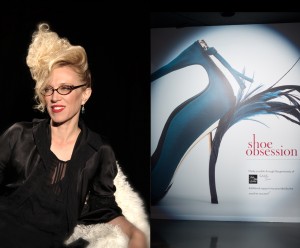SHOE OBSESSION: FIT’S VALERIE STEELE TALKS SHOES WITH MEGHAN CLEARY
Shoe Obsession, an exhibit currently up at the Fashion Institute of Technology’s museum in New York, features more than 150 pairs of extraordinary shoe styles of the 21st century, from Manolo Blahnik stilettos to Noritaka Tatehana avant-garde platform ballet shoes. JC Report’s resident footwear expert, Meghan Cleary, had a chance to sit down with Valerie Steele, the curator of the exhibit, who is also authoring a book by the same name, to learn more about the inner world of Shoe Obsession.
JC Report: What surprised you most when you were putting together the exhibition?
Valerie Steele: We’ve had an overwhelming response to this exhibition. It’sbeen flooded with more visitors even more than our Daphne Guinness show. We’re getting something like 600 a day during the week and 1,500 on Saturdays. It is absolutely mobbed on Saturdays. People just really, really, love shoes. They really are obsessed with shoes.
JCR: What is your favorite piece from the exhibition, and why?
VS: I really love the Bruno Frisoni for Roger Vivier eyelash shoe with the feathers coming out of the back. It’s fabulous. It’s so elegant and so new. The idea of drawing attention to the heel by having this sort of explosion of feathers at the back is just so brilliant. And I also really love the fetish ballet shoe by Christian Louboutin—I think a lot of the appeal of high heels is related to that incredible arch in the foot and you see that with the ballet dance en pointe. And so with this shoe, which is of course completely impossible to walk in, you have the sort of extreme fetish version of the ballerina en pointe. I love the Prada flame shoe too. It’s just so clever, this association of shoes with the kind of pop culture of ‘50s classic automobiles and the dynamism and wit of those shoes is amazing.
JCR: A really well built shoe is almost like a really well built car—true or false?
VS: It’s true. A lot of these shoes are really extraordinarily well constructed. As well they ought to be considering the price they cost, but the designers really are thinking clearly not only in terms of creative design, but in terms of the engineering of the shoe. I think that’s another area where with three-dimensional printing we’re going to be able to see all kinds of very interesting future designs once that gets a little less expensive. That’s going to really free up designers to do amazing things. And we also have other shoes in the collection like Conspiracy, this Italian brand—they use titanium, so I mean there’s all kinds of experimenting with new materials and new processes.
JCR: When you think about fashion and identity, where do shoes come into the picture?
VS: When I’ve interviewed women, they’ve talked about how shoes permit so much freedom to play and to exploit different aspects of personality and attitude, style and aesthetics in a way that you’d be reluctant to do head to toe.
JCR: Why did you name the exhibit Shoe Obsession?
VS: It seemed to me that that was the perfect term for it. It’s not just a love of shoes, and a term like addiction would sound to pejorative, it really does seem to be an obsession. Shoes, especially now, are like works of art or sculpture that people really admire almost as miniature works of art. So it seemed to me that obsession was the best term for this intense love. There is a little bit of an Imelda Marcos in every woman and a little bit of shoe fetishist in many men.
JCR: What type of cultural statement do you think designers like Noritaka Tatehana are making?
VS: Noritaka is self-taught and really began by investigating traditional Japanese aesthetics and those wooden geta sandals. What he does is a kind of fantasy shoe and he’s been tremendously influential with his heel-less high heel, which initially only a handful of people like Lady Gaga were wearing. And then when I discovered him and introduced him to Daphne Guinnes, she also was really thrilled with what he did. I think that the power of fantasy and imagination in his work, and also in that of some of the other Japanese designers who are featured in the show, is really extraordinary and kind of inspiring. Another of the shoes that I really love in the show that we got for the museum is his version of ballet shoes, which take you up 18 inches off the ground. He made a pair especially for Lady Gaga and then we asked him to make a pair especially for the museum.
JCR: In your opinion, how have shoe silhouettes changed over the years? Or have they changed?
VS: Oh they have, and I think in the last 10 years, which is the period that we focus on, what’s been most extraordinary has been how the heel itself has become higher and higher, and that in turn is related to the popularity of platforms. So the fact that you put a platform on the front of the shoe means that you can add one, two, three inches to the heel. That’s gone very extreme and people really had to learn how to walk in those shoes. Now there seems to be a pendulum swing back towards what’s called the single sole shoe where the sole is just one sole, not a kind of built in platform. Back to the Manolo Blahnik classic pump.
JCR: Why do you think that is?
VS: It’s gotten about as far as it can go. It’s typical for more inflationary effects in clothing, the mini-skirt went as high as it could go and then when socially, culturally, women wouldn’t wear it any higher, or their underpants started to show, then it dropped and we’re seeing the same thing. I mean now it’s gone so high that you have to be Lady Gaga to be able to walk in it. Although heaven knows people have trained themselves. Nicholas Kirkwood has said in interviews that some of his clients say that they really don’t want to give it up because they love being that much taller, and they’ve learned how to walk in it. For many women it’s more comfortable with a platform, but I think it’s reached its extreme and so we’re finding the pendulum effect back.
JCR: After doing this exhibit, would you say that the shoe defines the woman or that the woman defines the shoe?
VS: I think by featuring collectors as well as designers in the show, you can really tell the personality of the collector—it really comes through. These are women who could buy any shoes in the world and they buy often from the same designers but they have different aesthetics. You can really see some of them are fashion forward, others are more into absolute luxury and quality, others are more into a decorative aesthetic, or a kind of fierce aesthetic. I mean it’s very, very, different styles so I think that I wanted to make that point in the show. That it wasn’t just all these creative designers but that it was also women themselves building these collections of shoes which were in a way reflecting their own aesthetic.
JCR: In your opinion, who are the most innovative shoe designers working today?
VS: Innovative is a tricky word. We put a lot of designers in the show who are really more extreme designers. Often very young ones that you wouldn’t have heard of, but we appreciate the way they’re pushing the envelope and what they’re doing. In order to become a recognizable famous designer, you can’t do too much of that or you’re losing customers. So the younger designers who have come up in the world tend to be more like the Nicholas Kirkwood’s, the Charlotte Olympia’s. They’re creative obviously, but they’re not sort of ultra-extreme. I think that innovation has many forms, many of my women collectors in the show have shoes by Charlotte Olympia who’s one of a new generation of women designers coming to the fore. And often the collectors have said to me ‘oh her shoes are so comfortable!’ Meanwhile, you’ve got Louboutin who says, “my job is not to make shoes comfortable.” I think that there are different, not only different aesthetics but also different interests in the way that some of the shoes are coming out.
JCR: What are your personal favorite shoes to wear?
VS: Oh I’m addicted to Repetto shoes. It’s a brand where they make shoes for ballerinas. I got them initially with little ballet flats but they also make high heels and so you can get a very high heel, or pretty high heel, but they’re just really well structured. It’s very easy to walk in them and walk quickly and walk far—I’m a New Yorker so I walk everywhere.
Photo of Valerie Steele by Aaron Corbbett








